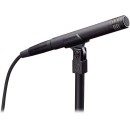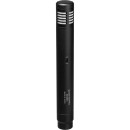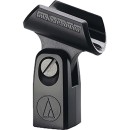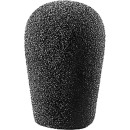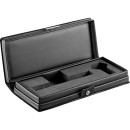Audio-Technica AT4041 Condenser Microphone: In-Depth Review
- Cardioid polar pattern for focused sound capture and minimal background noise.
- High-quality condenser element for accurate and natural sound reproduction.
- Low self-noise design for clear audio recording.
- 80 Hz high-pass filter switch to reduce low-frequency noise.
- 10 dB pad switch for handling high sound pressure levels.
- Durable construction and rugged design for reliable performance.
- Wide frequency response range from 20 Hz to 20 kHz.
- Ideal for studio recording, live sound, and broadcast applications.
Comprehensive Analysis of the AT4041's Features
The Audio-Technica AT4041 Condenser Microphone is a high-quality, small-diaphragm condenser microphone renowned for its outstanding performance and versatility. Designed for professional studio and live applications, it offers a broad frequency response and high SPL handling, making it ideal for capturing acoustic instruments, overheads, and other sound sources with precision and clarity.
This microphone features a gold-plated, externally polarized condenser capsule that ensures exceptional audio reproduction. Its cardioid polar pattern helps to isolate the desired sound source while reducing the pickup of unwanted ambient noise, providing clear and focused audio capture. The AT4041 also includes a switchable 80 Hz high-pass filter and a -10 dB pad, offering flexibility for use in various recording environments and on different sound sources.
The robust construction of the AT4041 includes a rugged metal body and a corrosion-resistant finish, ensuring durability for both studio and live settings. It also comes with essential accessories such as a stand clamp, windscreen, and protective carrying case, making it a comprehensive package for audio professionals who demand reliability and quality in their equipment.
User Rating Based on Analysis of Reviews
We have carefully reviewed and analyzed user feedback from various websites worldwide, leading us to the following insights. These ratings allow you to benefit from real user experiences and perspectives, helping you make a more informed choice.
Purchase Value
82% of users found the Audio-Technica AT4041 to be a great value for money, highlighting its affordability compared to other professional-grade condenser microphones. They appreciated its performance-to-price ratio, noting that it delivers high-quality sound capture typically expected from much more expensive models.
18% of users felt that the AT4041 did not provide sufficient value for their investment. Their dissatisfaction stemmed from the belief that the microphone's features and capabilities did not justify its cost, especially when compared to alternative options that offer similar or better specifications.
Quality of Materials
90% of users praised the AT4041 for its robust build quality and durable materials. They noted that the microphone feels sturdy and well-constructed, which gives them confidence in its longevity and reliability during professional use.
10% of users expressed concerns about the quality of materials, citing issues such as the microphone's casing feeling less premium than expected. They reported occasional problems with the build that led them to question its durability over time.
Sound Quality
88% of users were highly satisfied with the sound quality of the AT4041, appreciating its clear, crisp audio capture and ability to handle various frequencies effectively. They emphasized that the microphone excels in studio settings, providing a professional sound profile that enhances recordings.
12% of users were dissatisfied with the sound quality, mentioning issues such as unexpected noise interference or a lack of warmth in the audio output. They felt that these shortcomings limited the microphone's effectiveness for specific recording applications.
Ease of Use
86% of users found the AT4041 easy to use, noting its straightforward setup and user-friendly design. They appreciated the microphone's compatibility with various recording equipment and its intuitive operation, which makes it accessible even to those with limited technical expertise.
14% of users struggled with the microphone's ease of use, encountering difficulties with setup or integration with their existing audio systems. They expressed frustration over the lack of clear instructions or guidance, which made initial use more challenging than anticipated.
Durability
87% of users were impressed by the AT4041's durability, noting that it withstands regular use without compromising performance. They highlighted its resilience in various environments, making it a reliable choice for both studio and live settings.
13% of users had concerns about the microphone's durability, reporting occasional issues such as wear and tear or components becoming loose over time. These users felt that the microphone might not hold up as well as expected under heavy use.
Design
85% of users appreciated the sleek and professional design of the AT4041, noting its aesthetic appeal and compact form factor. They found the design to be not only visually pleasing but also functional, aiding in its versatility across different recording applications.
15% of users were not pleased with the design, citing that it lacked certain ergonomic features or that the aesthetic did not align with their preferences. They felt that the design could be enhanced to improve usability and appearance.
Reliability
89% of users commended the AT4041 for its reliability, emphasizing that it consistently delivers high-quality performance without technical issues. They reported confidence in using the microphone for important projects due to its dependable nature.
11% of users experienced reliability issues, such as occasional malfunctions or inconsistent performance. These problems led them to question the microphone's dependability for critical recording tasks.
Customer Support
78% of users were satisfied with the customer support from Audio-Technica, praising the responsiveness and helpfulness of the service team in addressing inquiries and resolving issues promptly.
22% of users encountered challenges with customer support, reporting delays in response times or unsatisfactory solutions to their problems. They felt that the support experience did not match their expectations.
Versatility
84% of users valued the versatility of the AT4041, noting its effectiveness in various recording scenarios, from vocals to instruments. They appreciated its adaptability, making it a suitable choice for diverse audio projects.
16% of users found the microphone's versatility lacking, mentioning that it did not perform equally well across all intended uses. They felt restricted in its application, limiting their recording options.
Portability
80% of users enjoyed the portability of the AT4041, appreciating its lightweight design that facilitates easy transportation and setup in different locations. They found it convenient for both studio and on-the-go recording needs.
20% of users were dissatisfied with the portability, citing that the microphone's design or included accessories did not support easy movement. They expressed a desire for a more travel-friendly package.
Frequency Response
88% of users were impressed by the microphone's wide and precise frequency response, which captures audio details effectively and produces a natural sound. They highlighted its ability to handle various sound dynamics without distortion.
12% of users were not satisfied with the frequency response, mentioning that it did not meet their expectations in capturing certain audio nuances. They reported issues with clarity or consistency in specific frequency ranges.
Sensitivity
87% of users appreciated the sensitivity of the AT4041, noting its capability to pick up subtle audio details and nuances, enhancing the clarity of their recordings. They found it particularly effective for capturing expressive performances.
13% of users were dissatisfied with the microphone's sensitivity, experiencing issues such as unwanted ambient noise capture or difficulty in isolating desired sounds. They felt this sensitivity affected the overall quality of their recordings.
Polar Pattern
85% of users were pleased with the cardioid polar pattern of the AT4041, which effectively isolates the sound source and minimizes background noise. They found it suitable for focused recordings in both controlled and uncontrolled environments.
15% of users were not satisfied with the polar pattern, as they encountered challenges in achieving the desired sound isolation. They felt that the microphone's directional capabilities could be improved for better sound capture.
Noise Handling
82% of users appreciated the microphone's ability to handle noise, noting its effectiveness in reducing unwanted background sounds and providing clear audio output. They found it particularly useful in less controlled recording settings.
18% of users were disappointed with the noise handling, experiencing issues with interference or excessive ambient noise capture. They felt that these problems detracted from the clarity and quality of their recordings.
Price vs. Performance
83% of users were pleased with the price-to-performance ratio of the AT4041, highlighting its ability to deliver exceptional audio quality at a competitive price point. They considered it a worthwhile investment for its level of performance.
17% of users found the price-to-performance ratio lacking, feeling that the microphone did not offer sufficient improvements over cheaper alternatives. They expected more distinctive features or enhancements for the price paid.
Compatibility
86% of users were satisfied with the AT4041's compatibility with various recording equipment and software, appreciating its seamless integration into their existing setups. They found it versatile across different platforms and devices.
14% of users encountered compatibility issues, such as difficulties in connecting the microphone to certain devices or software. They reported challenges in achieving optimal performance without additional adjustments or equipment.
Included Accessories
80% of users were satisfied with the accessories included with the AT4041, mentioning that they provide essential components for immediate use and enhance the overall value of the purchase.
20% of users were not pleased with the included accessories, feeling that they were insufficient or of lower quality than expected. They expressed a desire for more comprehensive accessory options to fully utilize the microphone.
Brand Reputation
90% of users trusted the Audio-Technica brand, citing its long-standing reputation for producing high-quality audio equipment. They felt confident in their purchase based on the brand's credibility and history of delivering reliable products.
10% of users were skeptical about the brand reputation, possibly due to past experiences or perceptions of inconsistency in product quality. They expressed concerns about relying solely on brand reputation when evaluating the product.
Warranty
77% of users were content with the warranty offered for the AT4041, appreciating the security it provides against potential defects or issues. They found the warranty terms to be fair and reassuring for their investment.
23% of users were dissatisfied with the warranty, feeling that it was either too short or lacked comprehensive coverage for potential problems. They desired more robust warranty terms that would offer greater peace of mind.
Overall Satisfaction
85% of users expressed overall satisfaction with the AT4041, praising its sound quality, build, and value as standout features. They regarded it as a reliable and high-performing microphone suitable for a variety of recording needs.
15% of users were not fully satisfied overall, citing a combination of minor issues such as design preferences, compatibility, or perceived value. These factors collectively impacted their overall impression of the microphone.
In the following sections, we will delve into the detailed specifications of the Audio-Technica AT4041 Condenser Microphone, examining its features, strengths, and potential drawbacks. Our thorough review aims to provide you with all the necessary insights to understand this microphone's capabilities.
Pros:
- High-quality sound with a smooth and natural audio reproduction.
- Wide frequency response, making it ideal for capturing a variety of sound sources.
- Durable construction with a rugged all-metal design.
- Low self-noise level, ensuring clear sound recordings.
- Cardioid polar pattern provides excellent off-axis rejection, reducing unwanted noise.
Cons:
- Relatively high price point compared to entry-level microphones.
- Requires phantom power, which may not be available on all audio interfaces or mixers.
- Lacks some of the advanced features found in higher-end condenser microphones.
- Not as portable or convenient for on-the-go recording as some USB microphones.
Microphone
| Primary Applications | Live Sound, Studio Recording |
|---|---|
| Form Factor | Small Diaphragm |
| Element Type | Condenser |
| Polar Pattern | Cardioid |
| High-Pass Filter | 80 Hz, 12 dB/Octave |
| Gain Adjustment |
Primary Applications: The Audio-Technica AT4041 is designed for a variety of audio applications, most notably in live sound and studio recording environments. Its versatility makes it suitable for capturing vocals, instruments, and other audio sources with clarity and precision. This adaptability allows sound engineers and recording artists to utilize the microphone in diverse settings, ensuring high-quality audio capture whether on stage or in the studio.Show More
Form Factor: The AT4041 features a small diaphragm design, which is particularly beneficial for capturing transient sounds and high-frequency detail. Small diaphragm microphones tend to be more sensitive to fast changes in sound pressure, making them ideal for recording instruments like acoustic guitars, violins, or percussion. This form factor also allows for easier placement in tight spaces, providing flexibility during setup.
Element Type: As a condenser microphone, the AT4041 utilizes a thin diaphragm placed in front of a backplate, which creates an electrical signal in response to sound waves. Condenser microphones are known for their wide frequency response and excellent transient response, making them ideal for capturing nuanced audio details. This type of microphone typically requires phantom power to operate, ensuring optimal performance and sound quality.
Polar Pattern: The cardioid polar pattern of the AT4041 means that it is most sensitive to sound coming from the front of the microphone while rejecting sound from the sides and rear. This characteristic helps to minimize background noise and feedback, making it particularly effective for live performances and studio recordings where isolation from other sound sources is desired. The cardioid pattern enhances the clarity and focus of the audio being captured.
High-Pass Filter: The microphone includes a high-pass filter set at 80 Hz with a 12 dB/octave slope, which helps to reduce low-frequency noise and rumble that can interfere with audio clarity. By filtering out these unwanted low frequencies, the AT4041 can produce cleaner sound, especially important in live and studio settings where clarity is paramount. This feature is particularly beneficial for vocals and certain instruments, allowing them to shine without muddiness.
Gain Adjustment: The AT4041 does not offer built-in gain adjustment, meaning users will need to rely on their audio interface or mixer to control the input level. While this may limit some flexibility in terms of on-mic gain control, it also simplifies the microphone's design, making it straightforward to use. Users will appreciate the ease of operation, focusing on achieving the best sound without the distraction of additional controls.
Performance
| Frequency Range | 20 Hz to 20 kHz |
|---|---|
| Maximum SPL | 145 dB SPL |
| Impedance | 100 Ohms |
| Sensitivity | -36 dB |
| Dynamic Range | 121 dB |
| Signal-to-Noise Ratio | 70 dB |
| THD | 1% |
Frequency Range: This specification indicates the range of frequencies the microphone can capture, from very low sounds (20 Hz) to very high sounds (20 kHz). A wider frequency range allows the microphone to reproduce a more accurate and detailed sound, making it suitable for various applications, including music recording and broadcasting.Show More
Maximum SPL: The Maximum Sound Pressure Level (SPL) indicates the loudest sound the microphone can handle before distortion occurs, measured in decibels (dB SPL). A higher SPL rating means the microphone can capture loud sounds without compromising audio quality, making it ideal for recording instruments like drums or brass that produce significant volume.
Impedance: Impedance, measured in Ohms, refers to the resistance the microphone presents to the audio signal. A lower impedance (like 100 Ohms) typically allows for better signal transmission over long distances and reduces the risk of interference, which is especially beneficial in professional audio settings.
Sensitivity: Sensitivity, expressed in dB, indicates how effectively the microphone converts sound into an electrical signal. A sensitivity rating of -36 dB suggests that the microphone is capable of picking up quiet sounds well, making it suitable for capturing detailed audio in studio environments.
Dynamic Range: The dynamic range measures the difference between the quietest and loudest sounds the microphone can accurately capture, measured in dB. A dynamic range of 121 dB means the microphone can handle a wide array of sound levels, making it versatile for various recording situations, from soft vocals to loud instruments.
Signal-to-Noise Ratio: This specification indicates the level of the desired audio signal relative to the background noise, measured in dB. A signal-to-noise ratio of 70 dB suggests that the microphone can produce a clean audio signal with minimal interference, ensuring high-quality recordings with less unwanted noise.
THD: Total Harmonic Distortion (THD) is a measure of how much the audio signal is distorted as it passes through the microphone, expressed as a percentage. A THD of 1% indicates that the microphone introduces minimal distortion, preserving the integrity of the sound and providing a more accurate representation of the source material.
Connectivity
| Analog Output | 1x XLR 3-Pin |
|---|
Analog Output: The analog output of a microphone refers to the type of connection it uses to transmit audio signals to other devices, such as mixers or audio interfaces. In this case, the AT4041 utilizes a 1x XLR 3-Pin output. This is a standard professional connector known for its durability and reliability, making it ideal for studio and live sound applications. The XLR connection helps to minimize noise and interference, ensuring high-quality audio transmission.Show More
Using a 3-pin XLR connector allows for balanced audio signals, which are less susceptible to electromagnetic interference. This is particularly important in professional audio settings where long cable runs can introduce unwanted noise. The quality of connectivity provided by the XLR output contributes to the overall performance of the microphone, ensuring that the captured sound remains clear and true to the source.
Power
| Power Sources | Phantom Power |
|---|---|
| Operating Voltage | 48 V |
Power Sources: The Audio-Technica AT4041 condenser microphone requires phantom power to operate. This means that it does not have an internal battery and instead draws power from an external source, typically a mixing console or audio interface. Phantom power is essential for condenser microphones as it enables them to function effectively, providing the necessary voltage for their internal circuitry to capture sound accurately.Show More
Operating Voltage: The microphone operates at a voltage of 48 V, which is standard for many professional audio equipment. This specific voltage ensures optimal performance, allowing the microphone to maintain high sensitivity and low noise levels. A stable operating voltage is crucial for condenser microphones, as it directly impacts their ability to capture a wide frequency range and dynamic sound, making them ideal for studio recordings and live performances.
Physical
| Color | Black |
|---|---|
| Dimensions | ø: 0.83 x L: 6.28" / ø: 21 x L: 159.5 mm |
| Weight | 4.23 oz / 120 g |
Color: The color of a microphone, in this case, black, is primarily an aesthetic choice but can also impact its visibility on stage or in a studio setting. A neutral color like black ensures that the microphone blends well with various environments, making it less distracting during performances or recordings.Show More
Dimensions: The dimensions of the AT4041 microphone, which are ø: 0.83 x L: 6.28 inches, indicate its size and shape. A compact design is advantageous for portability and can also make it easier to position in tight spaces. The diameter and length contribute to the microphone's handling characteristics, affecting how it interacts with sound and its placement in relation to sound sources.
Weight: Weighing in at 4.23 oz (120 g), the weight of the microphone plays a crucial role in its usability. A lightweight microphone is easier to handle and can be comfortably mounted on various stands or held during extended use. This is particularly important for live performances, where fatigue can be a concern for musicians and vocalists.
Packaging Info
| Package Weight | 1.13 lb |
|---|---|
| Box Dimensions (LxWxH) | 10.315 x 4.409 x 1.654" |
Package Weight refers to the total weight of the microphone and its packaging. In this case, the AT4041 weighs 1.13 lb. This is an important specification for users who may need to transport the microphone frequently or incorporate it into their audio equipment setup. A lighter microphone can be easier to handle and carry, especially for field recording or mobile applications.Show More
Box Dimensions (LxWxH) provide the measurements of the packaging in which the microphone is delivered. The dimensions of 10.315 x 4.409 x 1.654 inches indicate the length, width, and height of the box. Knowing the box size is useful for storage considerations and ensuring that the microphone will fit in your gear bag or equipment rack. Additionally, it can help with shipping and handling logistics if you're purchasing or sending the microphone to another location.
Customer Questions
How do I connect the Audio-Technica AT4041 to my audio interface?
To connect the Audio-Technica AT4041 to your audio interface, you will need an XLR cable. Plug one end of the XLR cable into the microphone and the other end into the XLR input on your audio interface. Ensure that your audio interface is powered on and has phantom power enabled, as the AT4041 requires phantom power to operate.
Why is there no sound coming from my Audio-Technica AT4041?
If there is no sound from your Audio-Technica AT4041, first check that the XLR cable is securely connected to both the microphone and your audio interface. Ensure that phantom power is turned on in your audio interface, as the AT4041 needs phantom power to function. Also, verify that the gain on your audio interface is turned up enough to capture the microphone's output.
What is the best position to place the Audio-Technica AT4041 for recording?
The best position for the Audio-Technica AT4041 depends on what you are recording. For vocals, place the microphone about 6-12 inches away from the singer's mouth at mouth height. For acoustic guitars, aim it towards the 12th fret about 6-12 inches away. Experiment with positioning to find the best sound for your specific recording environment.
How can I reduce background noise when using the Audio-Technica AT4041?
To reduce background noise, use the AT4041 in a quiet environment. Consider using soundproofing materials or acoustic panels. Position the microphone closer to the sound source to capture more direct sound and less room noise. Additionally, you can use a noise gate or noise reduction plugin during post-production.
Is the Audio-Technica AT4041 suitable for live performances?
Yes, the Audio-Technica AT4041 is suitable for live performances, particularly for instruments like acoustic guitar and overheads for drums. Its small diaphragm design captures detailed sound, but be cautious of its sensitivity to feedback when used in loud environments.
What is phantom power, and why does the Audio-Technica AT4041 need it?
Phantom power is a method of transmitting DC electrical power through microphone cables to operate condenser microphones like the AT4041. The AT4041 requires phantom power because it uses an active electronic circuit to capture sound. Ensure your audio interface or mixer can supply phantom power, typically +48V.
Can I use the Audio-Technica AT4041 with a computer without an audio interface?
Directly connecting the AT4041 to a computer without an audio interface is not recommended, as it requires phantom power and an XLR input, which most computers lack. You will need an audio interface that provides phantom power and an XLR input to connect and use the AT4041 with a computer.
How do I know if my Audio-Technica AT4041 is getting phantom power?
To check if your AT4041 is receiving phantom power, ensure the phantom power switch on your audio interface or mixer is turned on. If the microphone is working and producing sound, it is receiving phantom power. If not, check the connections and ensure the phantom power switch is activated.
What are the common setup mistakes with the Audio-Technica AT4041?
Common setup mistakes include not enabling phantom power, using a damaged or incorrect XLR cable, placing the microphone too far from the sound source, and not properly setting gain levels on your audio interface. Always double-check connections and settings to avoid these issues.
How do I clean and maintain my Audio-Technica AT4041?
To clean and maintain your AT4041, use a soft, dry cloth to wipe the microphone body. Avoid using any liquids or cleaning agents. Store the microphone in its protective case when not in use, and keep it away from dust and moisture. Regularly check and replace XLR cables to ensure good connectivity.
